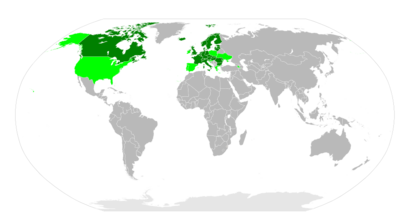
POP Air Pollution Protocol
Encyclopedia
The Protocol to the 1979 Convention on Long-Range Transboundary Air Pollution on Persistent Organic Pollutants is an agreement to provide for the control and reduction of emissions of persistent organic pollutant
s (POPs) in order to reduce their transboundary fluxes so as to protect human health and the environment from adverse effects.
It opened for signature on 1998-06-24 and entered into force on 2003-10-23.
Twenty-seven countries and the European Union
have ratified the treaty and a further nine have signed but not yet ratified.

Persistent organic pollutant
thumb|right|275px|State parties to the Stockholm Convention on Persistent Organic PollutantsPersistent organic pollutants are organic compounds that are resistant to environmental degradation through chemical, biological, and photolytic processes...
s (POPs) in order to reduce their transboundary fluxes so as to protect human health and the environment from adverse effects.
It opened for signature on 1998-06-24 and entered into force on 2003-10-23.
Twenty-seven countries and the European Union
European Union
The European Union is an economic and political union of 27 independent member states which are located primarily in Europe. The EU traces its origins from the European Coal and Steel Community and the European Economic Community , formed by six countries in 1958...
have ratified the treaty and a further nine have signed but not yet ratified.

See also
- Convention on Long-Range Transboundary Air PollutionConvention on Long-Range Transboundary Air PollutionThe Convention on Long-Range Transboundary Air Pollution, often abbreviated as Air Pollution or CLRTAP, is intended to protect the human environment against air pollution and to gradually reduce and prevent air pollution, including long-range transboundary air pollution.-Overview:The convention...
- environmental agreements
- International POPs Elimination NetworkInternational POPs Elimination NetworkThe International POPs Elimination Network is a global network of NGOs dedicated to the common aim of eliminating persistent organic pollutants....
(IPEN)

